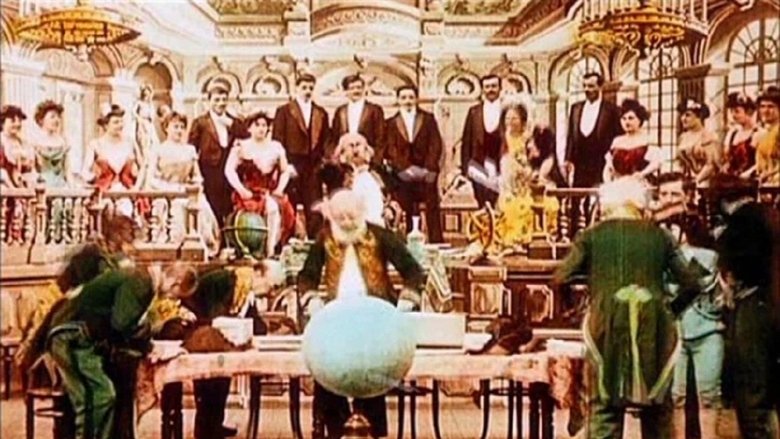The Impossible Voyage (1904)
Using every known means of transportation, several savants from the Geographic Society undertake a journey through the Alps to the Sun which finishes under the sea.
Watch Trailer
Cast


Similar titles
Reviews
Really Surprised!
Just what I expected
Don't Believe the Hype
An Exercise In Nonsense
This is a very important subject. What we are looking at here is one of the first epics. It's long for a Georges Melies film (24 minutes even), but it's a good watch. An Impossible Voyage is about a group of geographers who travel across the world in an assortment of vehicles to plot the world. The vehicles that they come up with are out there and unique, which only adds to the charm. It really has to be seen, to be believed. I always marvel at the amounts of effort gone into these films and An Impossible Voyage is just an amplification of that. This one, as I said, is long for a Melies film but it's really worth a watch. As a film, this is better than the 1 or 2 minute shorts that you will usually see. A Trip to the Moon, maybe the only Melies film as good as this one. I say, definitely give it a watch. It's fun and mesmerizing.
This movie did the impossible. It's still exist while other films from Georges Méliès didn't. This movie is one of the 200 out of 500 films that still around to watch. These factors was cause by Méliès' destruction of his original negatives, the French army's confiscation of his prints and the typical deterioration of time. Honestly, it's really hard to criticize a film that survive this long, but I'll do my best, to be fair. In my opinion, this movie doesn't have the same magic as his earlier film, 1902 Voyage dans la lune/A Voyage to the Moon. In many ways, it felt like retread. Based on yet, another Jules Verne's novel/play, this movie has a similar satire of scientific exploration in which a group of geographers attempt a journey into the interior of the sun, instead of the moon. It really seem like this film was trying to recapture that movie's charm. While, it's not, technically a sequel, it tries way too hard to copy the original film. It even tries to have an iconic 'bullet to the Moon's eye' scene, by having a scene where a train, goes through the sun's mouth. Like the first film, our great grandfathers were quite ignorant back, when it came to science, but I do not blame them. The sun used to be a very mysterious place before the space age. It's amazing to see what human beings used to believe. It's somewhat believable at the time, that the sun's core, could be cool, enough to allow human beings to survive. The movie tries to bring, something new, by having the explorers use every known means of transportation, at the time, to get there. There are scenes, where the Geographic Society undertake a journey through the Alps, so that, they can gather enough ice for their craft, so they can survive, the sun's extreme heat. Then, after, leaving the sun's surface, be able to cool, their craft under the ocean. These strange, surreal journeys somewhat in the style of Jules Verne, and are considered among the most important early science fiction films, though their approach is closer more to Sci-fantasy or Steam-Punk, as today's standards. While, this movie is indeed, an indulgence of joyous escapism and brain-bypassing spectacle. In many ways, I felt like this movie was trying to do, too much to top the first film. This movie is chaotic. It dissolves some of narrative structures, by not having title cards. It's really, up to the viewer to dissolve, what's the film is trying to show. This lack of narrative, can make this film; a very confusing watch. The wild action, and slapstick style make this really odd film to witness. The strength of the film is the visuals. The variety of incredibly creative sets and props is amazing. Méliès, a prolific innovator in the use of special effects, shows why he's call, 'The Cinemagician"; by using cinematic techniques, such as multiple exposures, time-lapse photography, dissolves, and hand-painted color in his work. Because of his ability to seemingly manipulate and transform reality through cinematography, Méliès's silent works can still, seem more entertaining, than any other silent films from the era. Certain themes are identifiable. A recurring feature is the pliability of the body, whether it transforms into something else. In this case, it's the face of the sun, turning from human to sun-like drawing. It's surreal. Surprising, this movie didn't have much eye candy. George Melies was known for putting beautiful women in his films and not giving them a part except to be wallflowers. Yet, this movie lacks that. Melies' moral philosophy is often Manichean and his feelings towards the opposite sex are ambivalent. Three kinds of women populated his pantomimes: angels, maids and temptresses. None of them, were really used here. This movie was nearly impossible for Georges Méliès to make. The production was once again created entirely inside the Montreuil studio and it really push his resources and ingenuity to his limits. The film was more expensive to produce than Trip to the Moon, and ran much longer. The film was 24 minutes in length (which at the time, was almost unheard). An optional 50-meter-long epilogue, was also filmed, but was sold separately. This supplementary section was believed lost until the 1970s, when a Méliès scholar John Frazer discovered it. However, it was lost, yet again, soon after, its discovery. Despite, being rare. This movie is easy to find on the internet. If you can't find; don't worry, because Director Martin Scorsese should clips of this film, in his 2011's film, 'Hugo', which tells a fictional story about Georges Méliès. Overall: While, a lot of people might not know, who George Melies and in my opinion, should watch Trip to the Moon, over this. This movie wasn't bad. It's quite meh (OK). In an era where so many directors were neither daring nor imaginative enough to make the impossible happen on screen, 'Le Voyage à travers l'impossible' is the pinnacle of early film-making. It's a must-watch for any silent film, fan.
Impossible Voyage, The (1904) *** (out of 4) Melies attempt to pass his landmark A TRIP TO THE MOON doesn't quite come close to that but this here is still an entertaining little film. Running 20-minutes, this tells the story of a Geographic Society who build a special ship that will take them through the sky, to the sun and then under the sea. That's pretty much the only type of plot we get here as the master Frenchman really makes for an inter sting film that has more going on for it visually than anything story wise. I must admit that I found what little story we have here to be quite boring as none of the human characters are all that interesting (not too uncommon for 1904) but the places they visit really aren't that interesting either. The look of all the locations is what makes this film worth seeing as there's no doubt Melies put a lot of imagination into everything we're seeing. I really loved the hand-colored stuff as this too had imagination behind it and it wasn't just a scribbled mess. The underwater sequence is a good one but the highlight would have to be when the ship goes into the mouth of the sun.
Released in 1904, cinematic magician Georges Méliès' 'Le Voyage à travers l'impossible / The Impossible Voyage' often stands in the shadow of the filmmaker's earlier success 'Le Voyage dans la lune / A Trip to the Moon (1902),' which has long-since earned itself the label of a cinematic classic. In many ways, however, 'Le Voyage à travers l'impossible' is a superior film, brimming with stunning set and model-work, creative visual effects, an exciting around-the-world journey and no shortage of imagination!At 24 minutes in length (which was almost unheard of at the time), 'Le Voyage à travers l'impossible' was no doubt heavily inspired by its more famous predecessor, as well as Jules Verne and Adolphe d'Ennery's play of the same name. The version of the film most commonly viewed nowadays (featured on the "Landmarks of Early Film Volume 2" DVD) features a hand-coloured print, supplemented with narration penned by Méliès himself.Like most of Méliès' films, the narrative is played out like a stage play, with the story usually divided into various distinct one-take scenes, the camera settled at a distance from the action. The first few minutes of the film are concerned with organising this "impossible voyage," which will entail the use of every known means of locomotion including trains, automobiles, dirigible balloons, submarines and boats. An engineer (played, I believe, by the director himself) explains his extraordinary plans to the members of a geographic society, who meet his proposal with wholehearted enthusiasm. The voyage itself is an unparalleled triumph of early visual effects. The members of the expedition are first whisked away in a fast-moving train, which is particularly significant in that, at the time, the train was seen as an invention that could take you anywhere. 'Le Voyage à travers l'impossible' takes this idea to the literal extreme, symbolic of the ever-expanding possibilities of the era.That iconic image of the scientists' rocket piercing the eye of the Man on the Moon has permanently become engrained in the minds of film-goers. In this film, we meet the Sun, who unexpectedly comes face-to-face with a flying locomotive. The gradual emergence of the Sun from behind the shifting clouds is a genuinely beautiful sight, and the face which comprises it is infinitely more pleasant than the nasty, ugly brute from a later Méliès film, 'L' Éclipse du soleil en pleine lune / The Eclipse: Courtship of the Sun and Moon (1907).' Letting out a wide yawn to welcome in the new day, the Sun is understandably startled when the expedition's soaring train enters its outstretched mouth, and he proceeds to cough trails of flame.On the surface of the Sun, the engineer and his band of fellow travellers set out to explore this strange new landscape, before the rising of the Sun precipitates a drastic rise in temperature (sounds unusual, but you'll have to suspend belief with this dubious logic). As all the explorers clamber into a specially-made icebox to cool down, all but the engineer are frozen into a block of solid ice. Rescued from a frosty fate by the leader of the expedition (who shrewdly decides to light a fire), the team tumbles into their only remaining means of travel a submarine and launch themselves off the face of the Sun and into the depths of the ocean.Some viewers may find it difficult to accept this film's questionable take on science and logic, but this all adds to the charm of it. Méliès a master of magician's tricks, puffs of smoke and impossible disappearances was never concerned with reality, but with transporting his audiences into a world quite unlike their own. In an era where so many directors were neither daring nor imaginative enough to make the impossible happen on screen, 'Le Voyage à travers l'impossible' is the pinnacle of early film-making.









